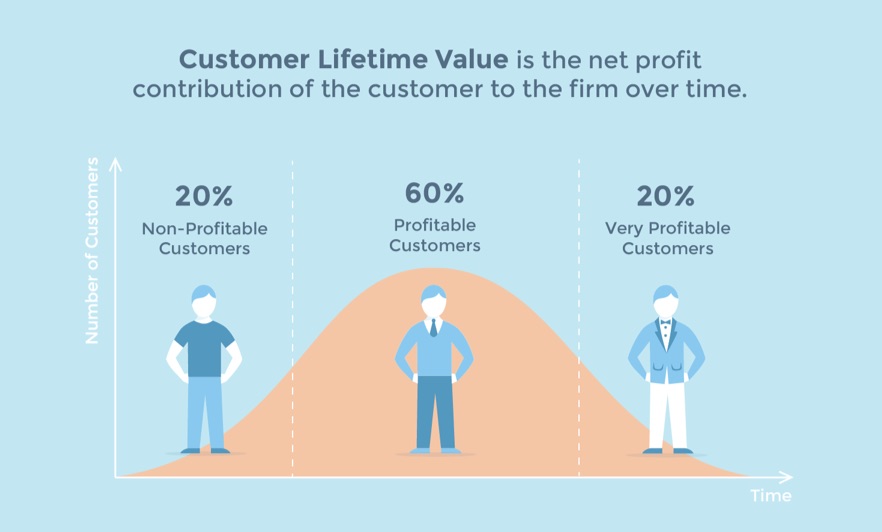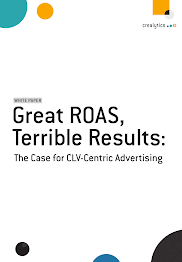In eCommerce, we spend a lot of time sifting through a long list of metrics. Conversion percentages, new customer rates, cost per order — it can all get a little overwhelming, but, what if I told you that there was one metric to rule them all? Enter, customer lifetime value (CLV).
CLV is the value that a customer will contribute to your company over their entire “lifetime” (usually 12-24 months). Essentially, it is the amount of money that they will spend on your products and services online shopping after the expenses of acquiring them as a customer. There are numerous types of CLV. The two most popular forms of CLV calculations are historic and predictive.
Historic CLV is a simple calculation. It is the sum of the gross profit from historic purchases made by a specific customer. This takes into account the expenses associated with the purchases that the person made.
Predictive CLV is generally a more worthwhile metric, albeit a bit more complicated to produce. Predictive CLV uses previous transactions, mixed with a variety of behavioral indicators that forecast a lifetime value for an individual customer. With each new purchase and new behavioral data, the Predictive CLV will change and become more accurate over time.
Why is CLV the most important eCommerce metric?

Customer Lifetime Value is an extremely important for online retailers. In digital marketing, it gained prominence with the rise of software-as-a-service but quickly found its way into eCommerce as well. The value of the metric has made it a staple among modern eCommerce businesses.
CLV is the single most important metric for measuring gross profit and success over time. The most expensive endeavor for eCommerce businesses is generating new customers. Customer acquisition can be cost prohibitive, and returns are often difficult to forecast. CLV attempts to answer that question.
Knowing the CLV of a customer will help you to strike the ideal balance between customer retention and acquisition. Knowing at what point a customer becomes profitable, is an essential part of knowing how much budget you can allocate to a particular channel or market.
Additionally, CLV provides real insights into your customer retention strategy. A steadily climbing average CLV shows that your retention and upselling efforts are paying off and having a real effect on your customer’s chances of returning.
How to calculate CLV
In order to make use of CLV in your eCommerce business, you first have to know how to calculate it. As we said earlier, there are multiple CLV versions that are commonly used. Let’s look at how both historic and predictive CLV, the two most common, are calculated:
Historic CLV
Historic CLV is a straightforward metric. You simply add all of the gross profit value up from all of their transactions. Here is the equation:
Historic CLV = (Transaction1+Transaction2+Transaction3…) X AverageGrossMargin
This is simple enough to be calculated in Excel as long as you have all of your transactional data on hand for a given customer. This should also take into account any expenses like service costs, returns, acquisition costs and other expenses to provide a clear picture of individual profit.
Of course, it can be complex to put together these expenses on an individual basis. Attributing certain costs to an individual customer is often problematic. When in doubt, use average to estimate until you can properly track expenses individually.
Predictive CLV
Predictive CLV tries to obtain an accurate CLV value for past and future purchases within your company. Here is the equation:
PredictiveCLV = ((AverageMonthlyTransactions x AverageOrderValue) AverageGrossMargin) AverageCustomerLifespanInMonths
This is a simple way to calculate predictive customer lifetime value. It provides a good picture of what the value of each individual customer is for your business. With that said — every industry is different and you may have to make specific changes to your CLV equation over time to have it accurately reflect the value of customers. There are more advanced versions of the Predictive CLV algorithm out there, and you should explore how well those options may fit your business model.
CLV vs. ROAS (return on ad spend)
Return on Ad Spend (ROAS) is the most commonly used profitability metric in eCommerce. It measures how much money you get back for every dollar that you spend on advertising. While similar to standard ROI metrics, it provides specific measurements for each individual marketing channel.
You calculate ROAS using this formula:
ROAS = (Revenue – cost) / Cost
While both CLV and ROAS have their place, it is important that you not rely too heavily on ROAS to gauge overall performance. ROAS-based models focus on whether your advertising is efficient but ignore if that’s the most effective way of growing your business. ROAS is all about winning that impression, click or customer engagement, but it doesn’t take into account the ultimate business measurements of profitability, margins, and new customer acquisition.
Customer Lifetime Value provides a bigger picture look at the value of each customer and sheds light on the real world effect process changes are having within your company. While both metrics attempt to account for the expenses and spending associated with every purchase, only CLV provides a clear long-term picture of expected profits from individual accounts.
Getting your retail business onboard with CLV

You may find it difficult to get everyone on board with integrating CLV into your daily workflows for a few different reasons. Primarily, people like to stick to the status quo and are resistant to change when current systems are “working,” despite the benefits that CLV could bring to the table. A few strategies that you can use to bring the rest of your team on board include:
Find an advocate
Chances are, you aren’t the only person that sees the value in optimizing for CLV. Ask around, and see if you can find another advocate for your changes. Try looking outside your own department as well. One of the benefits of optimizing for CLV is that, unlike ROAS, it can have implications in other departments like Customer Retention and Merchandising.
Present the facts
If you can’t find someone that understands the value, you’ll have to put it on display. Try to schedule a small meeting with relevant stakeholders that can help you to implement CLV into your workflows, and present them the benefits of doing so. Try to include real-world examples of CLV being used by eCommerce businesses.
Offer a trial
Your team will be unlikely to re-work all processes to include CLV without seeing it in action first. Try to identify a few small areas of your business where implementing CLV into the workflows would make a substantial difference, and ask for approval to use it within those contexts. PLAs provide a great place to test this kind of optimization. You can select a small group of products and see what optimizing for CLV does over time and compare it with a similar set of products that are optimized for ROAS.
Customer Satisfaction and CLV

One important thing to consider with CLV is the fact that customer satisfaction (CSAT) plays a huge role. The better your customer experience is, including the usability of your site and customer service is, the higher the lifetime value of each customer will be. Great customer service makes them more likely they are to buy from you in the future and stick around as a customer.
With that said, poor customer service can also have a large negative impact on your CLV data as well.
Adopting CLV
Customer Lifetime Value provides important insight into your operations as a whole. The big question is how much you should spend on all your advertising channels in order to achieve your total long-term revenue goals. Any eCommerce business should implement and use it frequently to measure their marketing and sales efforts.
Although it is a relatively well-known concept at this point, older eCommerce companies may be reluctant to adopt it and instead opt for more traditional metrics. In these cases, it is important to lobby for its usage and show examples of how it could have helped your business. Our research shows that when advertisers focus on long-term revenue goals, they make about 5 percent more revenue in the first year than when they focus on short-term goals like ROAS.
CLV can help to shed light on the areas of your business that must improve to increase your bottom line. Knowing customer lifetime value and profitability at the product level allows for improved paid media placement, intelligence in product pricing, and better inventory optimization.
Learn how you can apply Customer Lifetime Value to your performance advertising campaigns. Click below for Crealytics’ white paper, “The Case for CLV-Centric Advertising.”
Ready to use Crealytics to get smarter about CLV?






